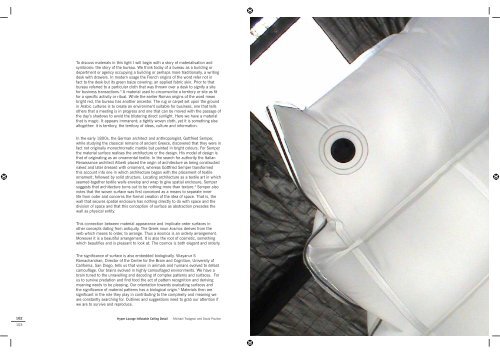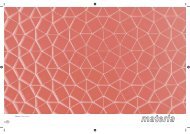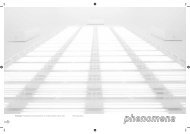Media - ross mcleod
Media - ross mcleod
Media - ross mcleod
You also want an ePaper? Increase the reach of your titles
YUMPU automatically turns print PDFs into web optimized ePapers that Google loves.
102<br />
103<br />
To discuss materials in this light I will begin with a story of materialisation and<br />
symbiosis: the story of the bureau. We think today of a bureau as a building or<br />
department or agency occupying a building or perhaps more traditionally, a writing<br />
desk with drawers. In modern usage the French origins of the word refer not in<br />
fact to the desk but its green baize covering: an applied fabric skin. Prior to that<br />
bureau referred to a particular cloth that was thrown over a desk to signify a site<br />
for business transactions. 3 A material used to circumscribe a territory or site as fit<br />
for a specific activity or ritual. While the earlier Roman origins of the word mean<br />
bright red, the bureau has another ancestor. The rug or carpet set upon the ground<br />
in Arabic cultures is to create an environment suitable for business, one that tells<br />
others that a meeting is in progress and one that can be moved with the passage of<br />
the day’s shadows to avoid the blistering direct sunlight. Here we have a material<br />
that is magic. It appears immanent; a tightly woven cloth, yet it is something else<br />
altogether: it is territory, the territory of ideas, culture and information.<br />
In the early 1800s, the German architect and anthropologist, Gottfried Semper,<br />
while studying the classical remains of ancient Greece, discovered that they were in<br />
fact not originally monochromatic marble but painted in bright colours. For Semper<br />
the material surface realises the architecture or the design. His model of design is<br />
that of originating as an ornamental textile. In the search for authority the Italian<br />
Renaissance architect Alberti placed the origin of architecture as being constructed<br />
naked and later dressed with ornament, whereas Gottfried Semper transformed<br />
this account into one in which architecture began with the placement of textile<br />
ornament, followed by solid structure. Locating architecture as a textile art in which<br />
seamed-together textile walls envelop and wrap to give spatial enclosure, Semper<br />
suggests that architecture turns out to be nothing more than texture. 4 Semper also<br />
notes that the woven surface was first conceived as a means to separate inner<br />
life from outer and concerns the formal creation of the idea of space. That is, the<br />
wall that secures spatial enclosure has nothing directly to do with space and the<br />
division of space and that this conception of surface as abstraction precedes the<br />
wall as physical entity.<br />
This connection between material appearance and implicate order surfaces in<br />
other concepts dating from antiquity. The Greek noun kosmos derives from the<br />
verb which means to order, to arrange. Thus a kosmos is an orderly arrangement.<br />
Moreover it is a beautiful arrangement. It is also the root of cosmetic, something<br />
which beautifies and is pleasant to look at. The cosmos is both elegant and orderly.<br />
The significance of surface is also embedded biologically. Vilayanur S<br />
Ramachandran, Director of the Centre for the Brain and Cognition, University of<br />
California, San Diego, tells us that vision in animals and humans evolved to defeat<br />
camouflage. Our brains evolved in highly camouflaged environments. We have a<br />
brain tuned to the unravelling and decoding of complex patterns and surfaces. For<br />
us to survive predation and find food the act of pattern recognition and deriving<br />
meaning needs to be pleasing. Our orientation towards evaluating surfaces and<br />
the significance of material patterns has a biological origin. 5 Materials then are<br />
significant in the role they play in contributing to the complexity and meaning we<br />
are constantly searching for. Outlines and suggestions need to grab our attention if<br />
we are to survive and reproduce.<br />
Hyper Lounge Inflatable Ceiling Detail Michael Trudgeon and David Poulton




